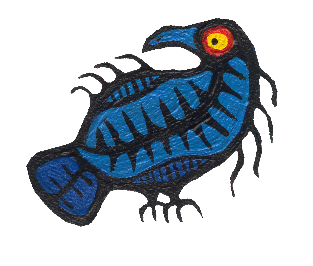Native-Art-in-Canada has affiliate relationships with some businesses and may receive a commission if readers choose to make a purchase.
- Home
- Woodland Symbolism
Woodland Art Symbolism
The Meaning of the Woodland Art Symbolism
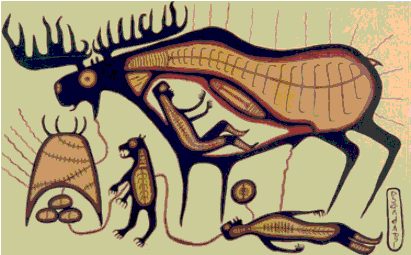 Norval Morrisseau - Unititled
Norval Morrisseau - UnititledFinally, woodland art symbolism explained!
When Norval Morrisseau first began painting, his intention was to re-introduce the Anishnaabe world view into the contemporary consciousness. The Ojibwa culture had been all but obliterated by the imposition of external governance and the influence of christian churches.
Using primary colours straight out of the tubes, Morrisseau painted the spiritual reality that had been the foundation of Ojibwa life for thousands of years. Raised by his shaman grandfather, Norval was familiar with the symbols used on the midewiwin birchbark scrolls. He knew the legends and he was intimately familiar with the ochre images that were everywhere on the rockfaces that bordered the waterways surrounding his ome.
Woodland art symbolism permeated his early paintings. The following may help you understand why he incorporated certain things into his imagery.
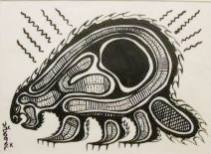 Josh Kakegamic - Untitled Josh Kakegamic - Untitled |
Lines of Power
Woodland art often shows lines of power radiating from the heads and bodies of both animals and people. The lines are usually short but the variations in length and intensity indicate the quality of power. The lines can both transmit and receive information. |
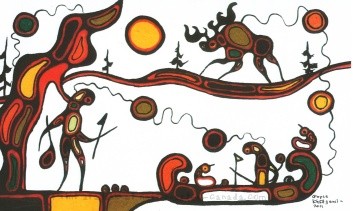 Goyce Kakegamic - "Legend of Red Lake" Goyce Kakegamic - "Legend of Red Lake" |
Lines of CommunicationWoodland artists often portray animals and people joined with flowing lines which indicate relationships which reflect the artist's understanding of the nature of the interdependence between the two beings. This is a painting by Goyce Kakegamic depicting the legend of Red Lake. |
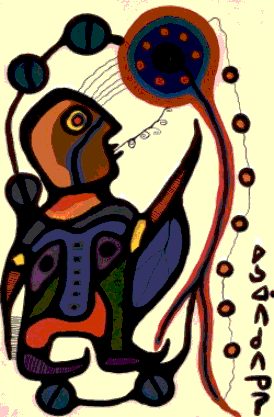 Norval Morrisseau - Untitiled Norval Morrisseau - Untitiled |
Lines of Prophecy
Some powerful creatures may have narrow ivy-like lines spewing from their mouths which indicate more than simple speech - they indicate prophecy, particularly in association with shaman imagery. A good example is this painting by Norval Morrisseau showing a shaman making direct communication with the universal life force. |
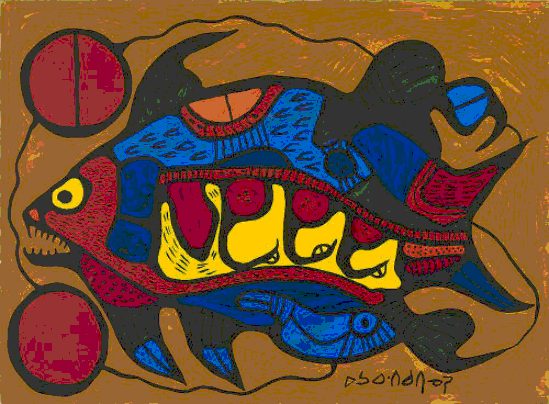 Norval Morrrisseau - Untitled Norval Morrrisseau - Untitled |
Lines of Movement
Very short lines, clustered near an organ like a heart as in this example, indicate movement and an active attempt at communication with the viewer. The lines are particularly significant surrounding shaking tent imagery. |
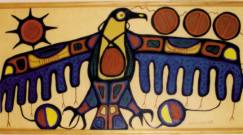 Norval Morrisseau - Thunderbird Norval Morrisseau - Thunderbird |
The Divided CircleA circle divided in half, connected with the main image by lines of communication is an especially meaningful symbol used by woodland artists. The divided circle represents dualities present in the world - good and evil, day and night, sky and earth, honest and dishonest, function and dysfunction for example. |
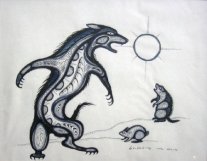 Carl Ray - Untitled Carl Ray - Untitled |
X-Ray Decoration
The term would have been meaningless to prehistoric woodland artists, but nowadays the concept of an x-ray view aptly describes the way woodland artists depict inner structures of people and animals. They are representations of inner spiritual life. |
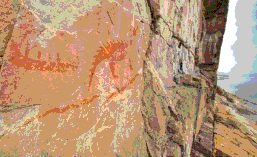 |
ColorIn prehistoric times the only significant colour used was red ochre as in this ancient image of mishpashu (a water spirit) on a cliff overlooking Lake Superior. In 1937 the image had been covered over with dark green oil based house paint by the twelve year old daughter of the local Indian agent. More than seventy years later the green paint has been destroyed by the elements but the original ochre illustration still stands proud. Fortunately Norval Morrisseau had a broader palette. He painted with unmixed acrylics straight from the tube for most of his career. He used colour intuitively to reflect what he said was the inner reality of the inner being. |
Woodland art symbolism was most prominent in the early legend painters like Eddy Cobiness, Carl Ray and, of course, Morrisseau himself. Symbolism was evident in the early works of Blake Debassige and Martin Pannamick.
Symbolism is still prominent in many of Leland Bell's work...particularly divided circles but sometimes he incorporates discrete lines of power.





